Motorhome travel: Sweden and Denmark
Words and photos by Felicity Martin
It’s a calm and colourful evening in Copenhagen. The old brick buildings along the waterfront glow warmly in the golden sunlight, contrasting with the blue sky overhead. People stroll and cycle along the walkways that extend around the waterfront. A few are swimming or kayaking in the translucent water. Using pedestrian and cyclist-only bridges, we complete a circuit without ever walking on a road, which pleases our collie, Braan, who is averse to traffic.
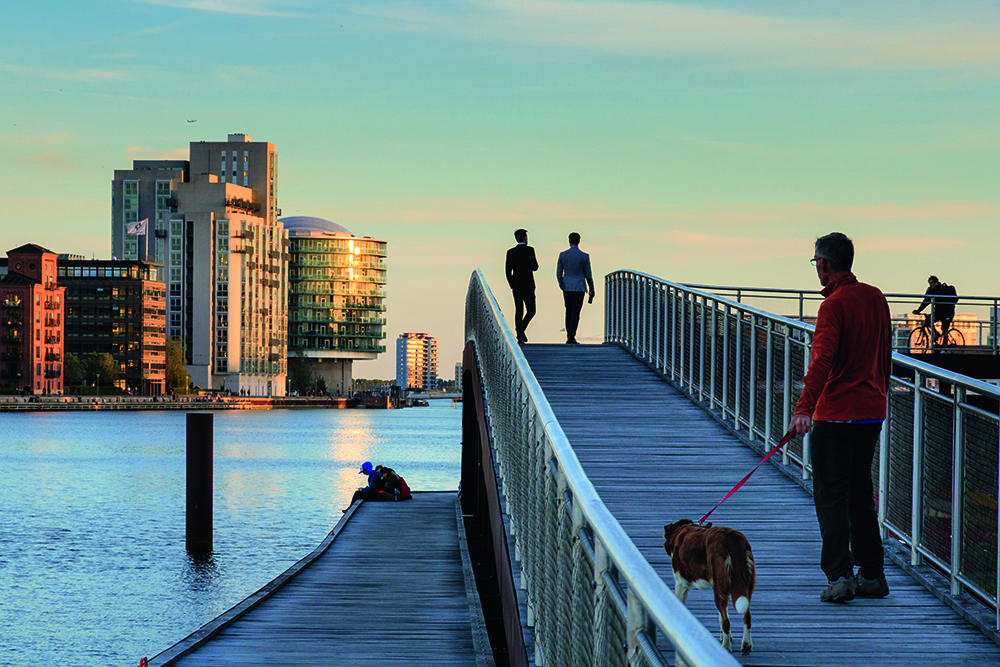
My husband, Andrew, and I are unwinding after a three-day journey from Scotland to Denmark via the Newcastle to Amsterdam ferry. This is our first trip abroad since buying our motorhome, Stella. We’ve traversed the Netherlands and Germany with the aid of CoPilot, an app downloaded to Andrew’s iPhone. Despite a few disputes between navigator and driver, it has painlessly guided us into Copenhagen in the rush hour.
Now the tension is dissipating as we attune to the relaxed atmosphere around us. We stroll past moored houseboats and, two minutes later, are back at Copenhagen CityCamp, a summer-only camperstop. I’m glad that I booked online beforehand, because no free space is left. Motorhomes are packed in like sardines, but we can’t see another with a GB plate.
The next day is one of our most memorable. Gitte, a friend who lives in Copenhagen, arrives to give us a tour of the city – on bikes and accompanied by our dogs on leads! I’m not sure how Braan will cope with this challenge, but she behaves impeccably as we take in Amalienborg (home of the Danish royal family), Tivoli Gardens, the Little Mermaid and other tourist hotspots. It works because most of the traffic is bikes and the few cars we encounter are driven slowly, with great respect for pedestrians and cyclists.
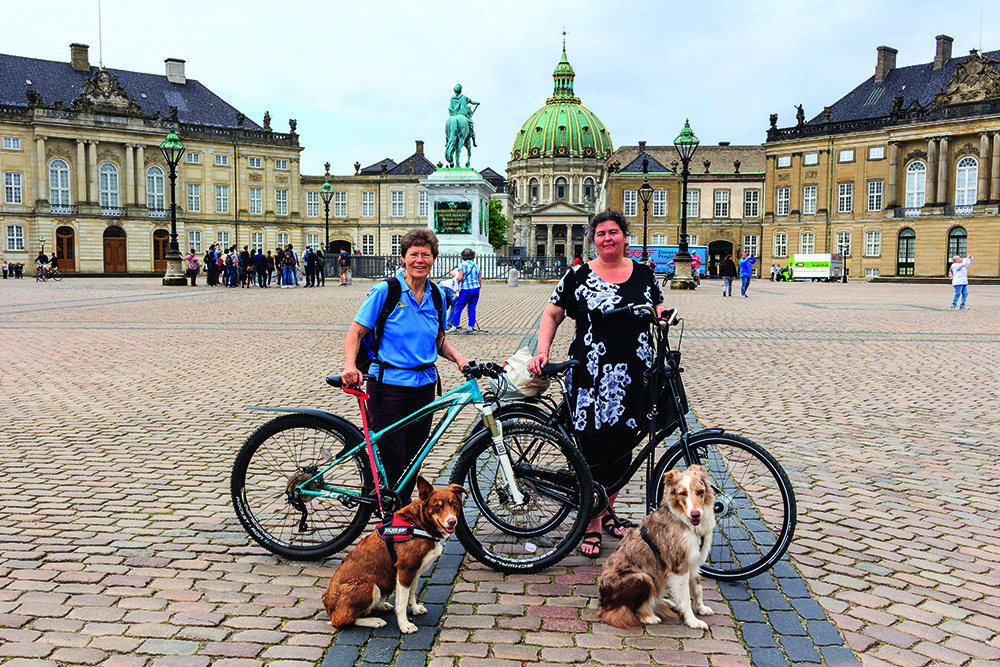
An easy drive out of Copenhagen leads us to the Øresund Bridge to Sweden. First, we dive into a tunnel under shipping channels, then emerge to cruise high above the silvery sea, suspended on five miles of steel. We have already paid, as we booked a combined ticket for the bridge and the Puttgarden to Rødby ferry. That crossing enabled us to make a beeline from northern Germany to Copenhagen, without driving up Jutland then west to east across the islands of Lolland and Zealand (Sjæland).
Our destination for the next two nights is just north of Malmö, where Andrew’s daughter, Helen, is living. A parking area outside her flat provides a level pitch and Helen’s landlord even offers us electric hook-up. We walk around the campus of Sweden’s Agricultural University where she is studying. It’s a delightful place, set in leafy parkland around an ivy-covered mansion.
Helen has planned a three-day tour for us, so we head north up the coast to Kullaberg Nature Reserve. This is one of the wilder parts of Skåne, Sweden’s most fertile and densely populated county, which occupies the country’s southernmost tip. We wind along a wooded ridge to a large free car park then walk along trails to a rocky headland that juts out into the Kattegat, giving views across to Denmark.
That night we stay at a small seaside campsite attached to a hotel in Höganäs. It proves expensive for a motorhome and a tent for Helen. This is the only time we stay at a site, choosing instead to wild camp or stay on a variety of camperstops.
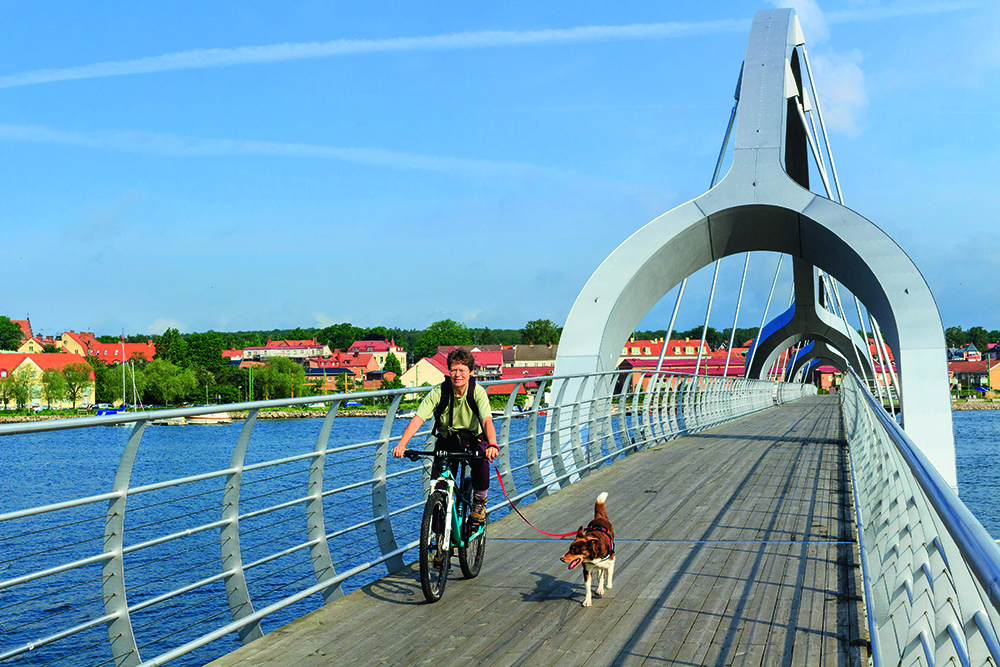
After a deep red sunset, the morning dawns fair for our trip to Ven, an island between Sweden and Denmark. It’s just the right size for cycling around, but it costs as much to take a bike on the ferry from Landskrona as to hire one, so we leave ours on our motorhome. The crossing is crowded, but there is no problem getting wheels as hundreds of hire bikes await us. We ride quiet paths along the shore with frequent stops. Highlights for me are medieval St Ibb’s Church, with ochre decoration on its vaulted ceiling, and the observatory of Tycho Brahe, a ground-breaking sixteenth century astronomer who wore a metal prosthesis to replace his nose lost in a duel.
Our last day with Helen is spent further inland in Skåne at Söderåsen National Park, a large area of protected woodland. We walk along a deep, shady valley and return above cliffs, passing Hjortsprånget, the ‘deer leap’ where Stone Age men drove their quarry over the edge. It takes some nerve to step out along the narrow promontory for an uninterrupted view over the canopy of beech trees.
After taking Helen home, we head west out of Skåne to less developed parts of Sweden. There’s no way we can see the whole country in a fortnight and we don’t want to spend too much time driving, so we head across to the east coast and slowly bumble up it, then return cross-country. Andrew sets CoPilot for Sölvesborg in Blekinge county, where we meet the sea again.
A local woman sees me looking at the town map and directs us to the harbour where, she says, we’ll find space to park. From here we visit St Nicholas’ Church, on the site of a Carmelite nunnery and come upon Europe’s longest cycle bridge, connecting to a peninsula. We decide to stay the night where we are parked and cycle over the bridge the next day.
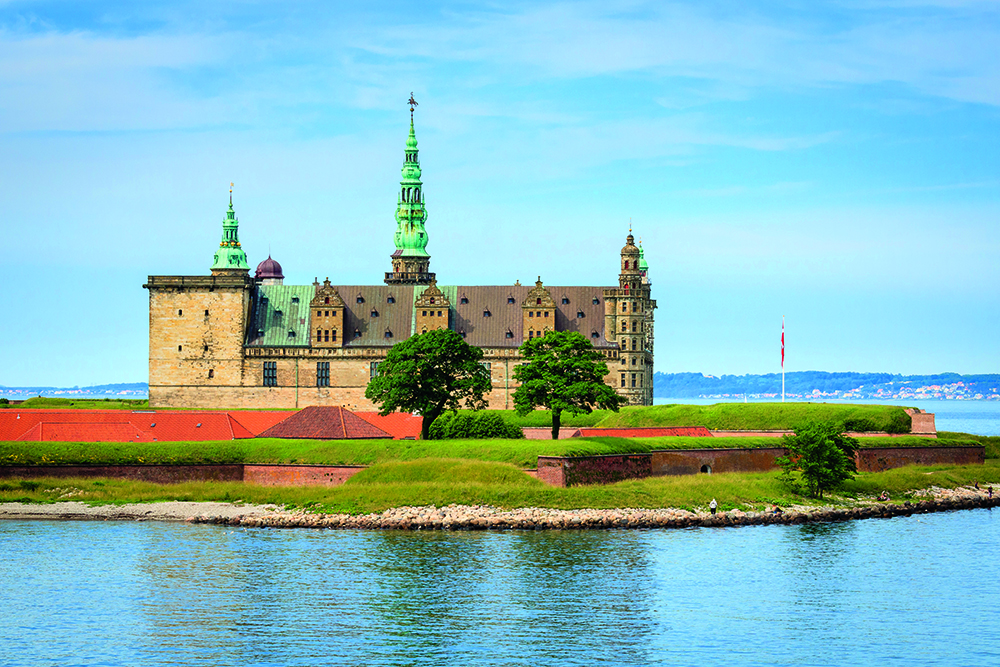
After our ride we continue along the coast and the Nordic Camper Guide (our ‘bible’ for this trip) comes up trumps, leading us over a causeway on to the nature reserve island of Almö. The free Tjuravicken camperstop is a grassy field with trees on one side and pasture grazed by cattle on the other. A path along the tranquil shore leads to a barbecue site and swimming jetty, from where I watch great crested grebes.
In the morning we take a longer walk through juniper heathland full of wildflowers and dragonflies. We are serenaded by birdsong; whitethroat, blackcap, yellow hammer, willow warbler and chiffchaff and I have my first-ever sighting of a great grey shrike. Barnacle and greylag geese with rafts of goslings shelter between rocky islets and eider ducks with ducklings drift along the shore.
No cars in Sweden use Autogas, so LPG is scarce. Again, the Nordic Camper Guide helps us out and we refuel at a builders’ yard in Mörrum where a friendly assistant shows us the gas adaptor we need to use. He tells us that we shouldn’t miss the historic naval town of Karlskrona, so that is our next stop. We find on-street parking and wander into a massive square, surrounded by imposing buildings with a statue of Karl XI at the centre. It would be easy to spend all day in this World Heritage Site, but we content ourselves with buying vegetables from the market and having lunch in a konditorei.
That evening we are back in our preferred habitat of nature. We’ve crossed the toll-free 6km (3.72-mile) bridge onto Öland, a long, thin island off the southeast coast of Sweden and are in a large, grassy field that is the car park for Himmelsberga Museum, another free camperstop. We share the field with hares, a grey partridge and a small wooden windmill, one of dozens on Öland. Swifts zoom over the grass catching insects, while red kites and buzzards soar high above. As dusk falls, the barks of roebucks ring out from surrounding fields. We wake to the sound of cuckoos in the ash trees around the museum.
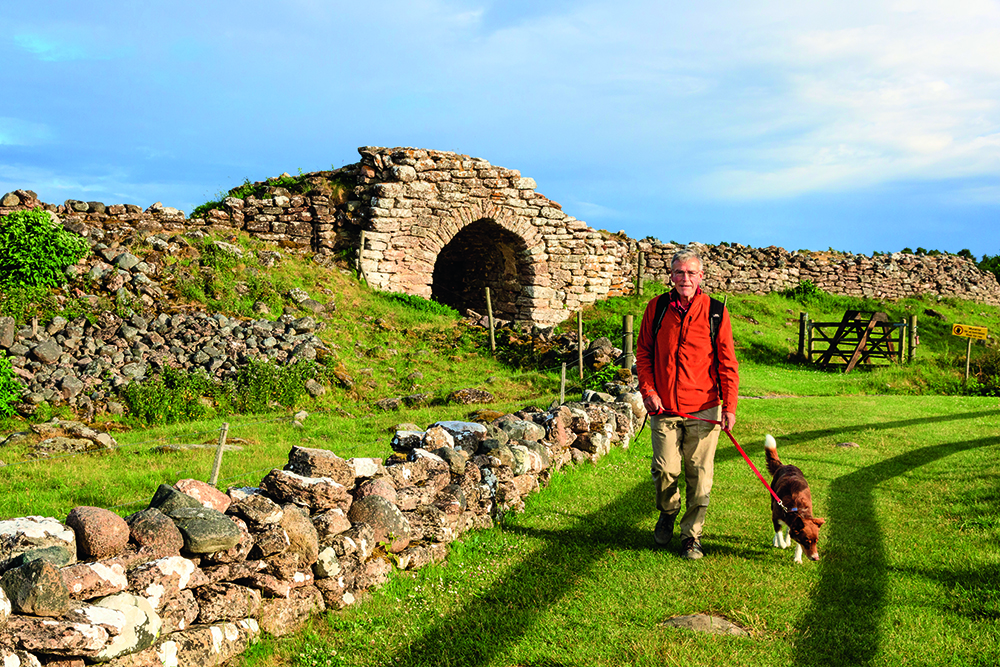
The Långlötleden, a 6km waymarked walk, takes us all morning because we are so entranced by the different orchids and other wildflowers we see, including many species new to us. The route leads through a pastoral idyll of woods, hedges and low-intensity farming. During the languid afternoon we explore the museum, which preserves a traditional linear farm village of 200 to 300-year-old buildings. Braan is allowed in the outside areas so we take it in turns to visit the farmhouses.
Öland has cast its spell over us and we linger, spending further nights at Kårehamn, a harbour camperstop with immaculate facilities and in the car park of Möckelmossen Nature Reserve. Möckelmossen is a shallow lake on the Stora Alvaret, a vast limestone plateau. As with everywhere else in Sweden, the interpretation boards are also in English and are very informative about the distinctive flora and fauna of the area. Only sparse vegetation manages to grow in cracks and, with the flat landscape, I feel as if I am at sea; the horizon is far off and level in all directions.
There is plenty of natural, historic and archaeological interest on Öland, from the 1,000-year-old oaks of Halltorps hage to the ruins of seventeenth century Borgholm Castle and prehistoric Mysinge burial ground. We could easily spend days here.
Heading slowly homeward, we spend two nights around Möckeln, a wooded lake in Kronoberg county. The unspoilt rural peace of Höö Nature Reserve and Linnés Råshult, the birthplace of Carl Linnaeus (the scientist who established the naming system we use to classify all lifeforms), contrast with the urban modernity of the adjacent town of Älmhult, the home of Ikea.
Our departure from Sweden is by ferry from Helsingborg to Helsingør in Denmark, the shortest distance between the two countries. We haven’t booked, but a ferry leaves every 15 minutes. We simply roll up and pay, then are straight on board for the 20-minute sailing. I’d been told that the best view of Hamlet’s Castle is from the ferry, so I am poised on deck with my camera.
That night we stay at a farm camperstop, a very relaxed affair where we park in the owner’s garden and leave the modest fee in an honesty box. In the morning we walk through lime avenues and past innumerable sculptures in the gardens of Fredensborg Palace, which is regularly used by the Danish royal family. A drive southwest across Zealand takes us to delightful Skælskør harbour, another fully serviced camperstop, where we struggle to master the automatic payment machine. A sensor on the 18km-long (11-mile) Storebælt (Great Belt) Bridge linking Zealand to Funen registers our bikes on the back, so we must pay the higher rate for vehicles over 6m at the toll booth.
Then we drive southwest again, but are diverted by Bøjden Nor nature reserve. We walk to the hides and see avocets and many other species on a brackish lagoon. The car park is in a glorious spot, so we spend the night here, a few paces from the sea. A shorter, toll-free bridge carries us across the Lillebaelt (Little Belt) from Funen to Jutland, Denmark’s ‘mainland’ peninsula. We spend most of the day at the Jelling Monuments, Europe’s finest Viking Age site. Entry is free to the interactive experience centre and the whole World Heritage site, which has runic stones, a church, two barrows and a large stone ship burial.
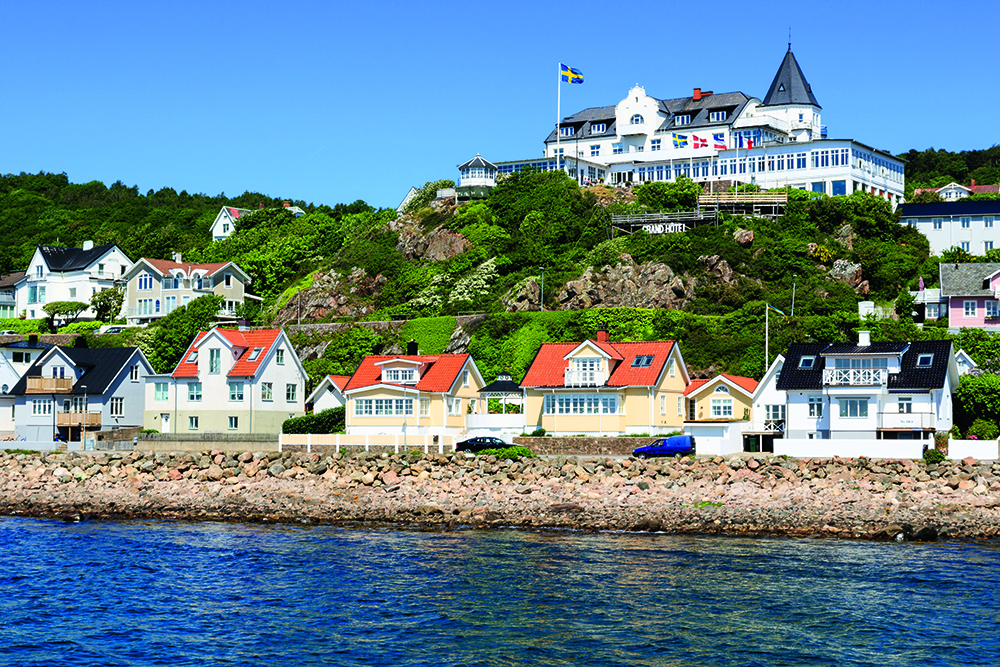
We stay at a farm outside Ribe, Denmark’s oldest town, then spend the morning exploring its cobblestone streets of half-timbered houses. We have time for a short visit by causeway to Rømø, an offshore holiday island of sand dunes and pine woods, before we drive south into Germany. Arriving in the dark, we park outside the gates of a campsite at Buchholz, south of Hamburg.
Our final night is spent in the Netherlands at Lelystad on IJsselmeer. Here, a grassy dyke separates the camperstop from a beach and marinas. In the morning, we cycle along the seafront and back through a wooded park on traffic-free paths. By simply following our noses we have explored some glorious, unspoilt countryside rich in heritage. But we can’t understand why none of the other motorhomers we met on the way were British.






.jpg)


Recent Updates
Engine management lights: all you need to know
What is the engine management light? What does it mean, and what do I have to do? ...
Motorhome air suspension: all you need to know
Motorhomes are heavy and the additional weight of equipment and height of the bodywork can increase the loads ...
Motorhome WiFi: how to get better motorhome internet
Staying connected on the move is more and more essential, so relying on campsite WiFi isn't an option – here ...
A class of their own - our guide to A-class motorhomes
Thinking of trading up to an A-class, or even going straight to the top of the motorhome tree? We guide you ...
Explore overseas on a motorhome dream tour
Enjoy exotic travel in a campervan or motorhome by hiring, swapping with someone else or exporting your ...
Motorhome water systems: everything you need to know
On-board water is an important part of every motorhome – here’s everything you need to know ...
Campervanning in Europe: what you need to know
Whether you're planning a leisurely drive through the French countryside, navigating bustling city streets in ...
Campervan security: all you need to know
With thefts on the increase, it’s important to know how to keep your campervan secure and prevent campervan ...
Campervan furniture: everything you need to know
Our campervan experts guide you through all the essentials for your campervan, including tables, chairs, ...
Campervan finance: how to fund your purchase
Here we look at the different types of campervan finance available, to help you decide what’s the best option ...
Other Articles
Britain’s best used motorhomes
Want a great motorhome without paying the premium for a new one? Here's a guide to the best you can get in the pre-owned market for each layout, ...
Which motorhome? Choosing the perfect motorhome for you
Choosing a motorhome or campervan is one of the biggest buying decisions you’ll ever make, so it's important ...
Campervan washroom essentials: stay fresh on the road
Our guide will take you through the campervan washroom essentials you'll need so you're well-prepared for ...
Dogs in campervans: all you need to know
Follow our advice and your dog will enjoy campervanning as much as you do ...
Electric campervans: all you need to know
Our guide will take you through everything you need to know about electric campervans and what the future ...
Motorhome electrics: a complete guide to your motorhome electrical set-up
Motorhome electrics can dramatically enhance the convenience and comfort of your vehicle – but they can be ...
Lighting for campervans: all you need to know
We guide you through all the lighting options available for you and your campervan, including interior ...
Electric bikes for motorhomes: our ultimate guide
Read our comprehensive guide to electric bikes for motorhome owners, helping you add electric power to your ...
Our guide to 'cheap' motorhomes in 2024
If you're on the hunt for an affordable new motorhome, this is the best place to start – we've rounded up a ...
Campervans in winter: all you need to know
Here's your guide to preparing your campervan for the colder months, whether you will be using it or putting ...